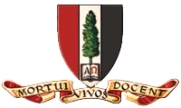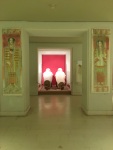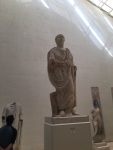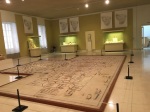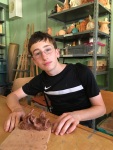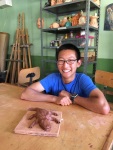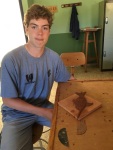With most of Cádiz sound asleep after celebrating Spain’s decisive victory in the Eurocup the day before, we got up bright and early today for another Saturday excursion. This time, it was to Los Pueblos Blancos, or the White Towns of Andalusia. Los Pueblos Blancos are a group of small towns just over an hour drive away from Cádiz, and they are called “white” because almost every house in each town has white walls:
All 28 of us — including the new arrivals of Señor Walsh and Doctor Guerra’s parents — crammed into a 28-seat bus, and we were on our way.
The first town we visited was El Bosque, where we learned how they use a water mill to make bread in a site called El Molino de Abajo. Led by the owner of the mill, Fran, and his father, Juan, we learned how they obtain and use the four ingredients of bread: flour, yeast, salt, and water. To end our tour, we got a firsthand look at the system at work.
Then, it was time to make our own bread. Our first task was to sift the flour, which led to a few small competitions to see who could do it fastest. Unfortunately, we did not see an Ayinde-Rohan rivalry rematch, but we did see some strong performances:
Caption: Mahamud is too fast for the camera, while Carson “Cochehijo” Straub holds his own. (Also, what is Rohan doing in the back?)
Caption: Rohan “First Round Pick In Every Sport” Balakrishna proves his worth in flour sifting against Zach Levin.
Caption: Grady finishes up, while Evan is just beginning.
After we finished (some evidently more quickly than others), we threw all the ingredients into a machine to knead the dough, and it was soon ready. We were each given a small piece of dough, and we were told to create whatever we wanted — one of the worst things you can say to a group of RL kids, as we found out in the ceramics workshop yesterday. However, it turned out surprisingly well:
Fortunately, we did not have to sit around and watch our bread bake for 45 minutes. We had a bit of free time before heading off for our hike, so we decided to hold a few races on a private road nearby. Still furious over his controversial loss last Saturday, Ayinde challenged Rohan to a rematch, but apparently Rohan “didn’t eat breakfast today” and “was not wearing athletic shorts” (the latter was true, but it is widely believed that the former was false). Sadly, the highly anticipated rematch did not take place.
Soon, we began our hike. This was a 5 km hike to the town of Benamahoma, alongside the river Majaceite, and we were glad to find that much of it was in the shade. Andrew Steinberg led the way for much of the hike, scaring many of us who were recalling his recent history of being late to our meeting places. Surprisingly, we did not get lost, and we got to Benamahoma on schedule! A few photos from the hike:
When we arrived at Benamahoma, we enjoyed our packed lunches, chatted (all of it in Spanish; no need to worry, Dr. Guerra), and played cards. We also received our bread from earlier, which turned out quite well. Of course, it wouldn’t be an RL lunch without something shattering:
The culprit will go unnamed.
After lunch, we packed into our bus to head to Grazalema, another town in the region. We did not have a scheduled activity here, but rather we had free time to walk around the town. There was an art convention while we visited, and we saw some pretty impressive works:
After about an hour in Grazalema, we went for a swim in a natural recreation area in Arroyomolinos. A group of about 12 of us played Waboba with a Spikeball, where Joe Nero blocked just about every throw in his direction, showing flashes of a young Manuel Neuer, and where John Philippides received several wounds to the chest. Even though things got heated — there was much controversy over one particular player wearing highly protective body armor — we had a good time in the end.
Caption: Robert jumps a little too early. (Or maybe with a smaller upward velocity, as we learned in Physics…)
There was still one destination left on our checklist: Zahara de la Sierra, one of the towns with the most fascinating views in the region. We walked up to the town’s castle to take in the sight of the surrounding hills, and were not disappointed:
Caption: Robert Cunningham can’t get to the top in time, and the group decides to take a photo without him.
With everything on our itinerary checked off, we headed back to Cádiz, and arrived at around 9:00 PM. Although we would usually make our daily visit to the beach (where Will Connaughton still leads the Beach Football League in just about every receiving category), today we were far too tired. And yes, 9:00 is a good time to go to the beach in Cádiz; one of the things that I have loved most here is the unfailingly great weather and daylight. For example, I took this photo at 9:00 PM one day:
Instead of heading to the beach, I went straight home to watch the Eurocup match with my Spanish parents. Speaking of my parents, I would be remiss if I didn’t talk a bit more about them. They have welcomed me in every way, preparing meals for me, washing my clothes, and stooping all the way down to my level of Spanish to help me learn new words. Their children are grown up and don’t visit very often, so it is usually just my father, my mother and I at home, but there is always plenty of discussion about the day’s activities, the news, or a TV show that we’re watching. I’ve heard that almost everyone’s parents are amazing cooks, and my mother is no exception; I have enjoyed every dish at every meal, even though I have never even heard of most of them before. Although the meals, in all honesty, sometimes do not look too appetising at first, it has been important for me to try everything, as I’ve found new, rich tastes that I would have missed otherwise. In addition to helping me understand the native accent of Cádiz, my parents have answered all of my vocabulary questions (and believe me, I’ve asked many), and I’ve learned so many new Cádiz-specific words.
With our last Saturday excursion in the rear view mirror, I am only just realizing that our time in Cádiz is dwindling down. Everything has flown by so quickly; in less than a week, we’ll be saying goodbye to our host families, and in less than two weeks, to Spain as a whole. We can only hope that these last two weeks are just as fun, engaging, surprising, tiring, and (everyone’s favorite) educational — if not more — as these first two weeks have been.
–David Ma
